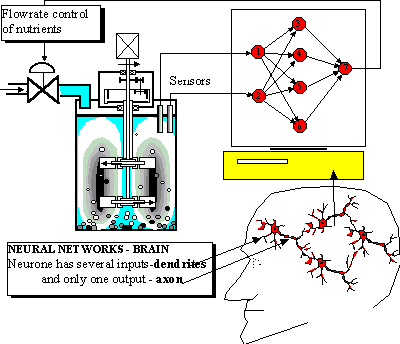
This fermentor can also be controlled manually, and the software only observes the reactions of the system to the manually adjusted flowrate. The aim of "learning" is to reproduce the behaviour of a skilful operator, even if the actual state of the fermentation process does not correspond to the situations monitored during the process of learning. The neural network concept assumes that the "know how" of a human operator is hidden not inside his neurones, but in the particular setting of the synapses. The neural network analogy substitutes neurones by very simple subroutines (objects), which are able only to sum up the input signals from the synapses and transfer the result to an axon (the signal can be conditioned, e.g., converted to a binary signal using a preselected threshold value). A "memory" of the neural network is encoded into the weights wij of the synaptic connections between the neurones i and j. The process of learning consists in a continual adjustment of these weights (signal gains). It is not a big problem to define the neural network with three layers (the input layer, the computational /called hidden/ layer and the output layer) formed from a small number of neurones using e.g. Excel (see Fig. 11.17 - model, Fig.11.18 corresponding sheet). However, even for such a small system it is not very easy to identify the weighing coefficients wij by comparing the prediction (the output of the neurone N7) with the monitored data. Thus, more specialised software (for example BrainMaker) and algorithms have to be used, Bíla (1996). Remark: The number of neurones is seldom more than a few thousands in neural networks, while the human brain contains approximately 1011 neurones and 1015 synapses.
Another field of research investigates the possibilities of monitoring, decoding or even affecting the information flow in living neuronal systems. An example is the "neurochip", a silicon chip with living neurones, where the underlying electronic circuitry monitors the electrical activity of the neurones. The activities of the brain can also be analysed by measuring the electrical field generated by active neurones. The time series of the monitored spikes are processed by the Fourier, correlation and cluster analysis, with the aim of understanding if not whole "sentences", then at least the "words" of messages transferred between neurones, see Reinis (1997). The results may be used for computer modelling of artificial nerve systems and for improving neural networks. It is hard to say if monitoring and stimulation is also possible at a distance, but if it is, then seemingly innocent "virtual reality" computer games would become dangerous. Imagine for a moment that all the axons connecting your brain to your sensory and mobility system were under the control of a computer equipped with a software, e.g., on the basis of neural networks. The computer would read the commands given by your brain and would substitute the information flow from your sensory apparatus (sight, taste, etc.) with its own model of a virtual world. Assuming perfect technical realisation, it would be difficult to work out whether you were in the virtual world or the actual world even if your brain was not compromised.
The Czech title Huxley's book, mentioned above, is "End of Civilisation". That has not yet arrived. However, we have almost reached the end of this textbook.